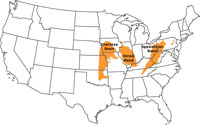2.15: Pennsylvanian Period (323 to 299 million years ago)
- Page ID
- 9783
Pennsylvanian Period (323 to 299 million years ago)
The Pennsylvanian Period is named for the coal-bearing region in the Appalachian Plateau and Mountains region). Great coastal forests and swamplands covered large regions of North America and parts of Europe. Great coal deposits formed from extensive swamps that trapped organic sediments in locations around the world. Pennsylvanian rocks are perhaps best know for their coal-bearing basins in the Appalachians and Midwest regions (Figures 2-33 and 2-34).
 |
 |
| Figure 2.33. Pennsylvanian age coal-bearing basins in the eastern United States are part of the Absaroka Sequence. | Figure 2.34. Reconstruction of a swamp forest of the Pennsylvanian Period. |
Perhaps the greatest evolutionary innovation of the Carboniferous Period was the development of amniote egg which allowed lizard-like tetrapods to advance. Reptiles evolved and became the first totally terrestrial vertebrates, descendant from amphibian ancestors. With the abundance of vegetation on land, arthropods flourished, including species of insects that are much larger than any found on Earth today (Figure 2.31). In Pennsylvanian time, glaciation cycles in the Southern Hemisphere caused repetitious rise and fall in sea levels. The Appalachian and Ouachita Mountain systems also began to develop as ancient forms of the continents of Africa, South America, and North America began to collide with one-another.
It was during the Pennsylvanian Period that the world's continents assembled together to form the supercontinent of Pangaea (discussed in Chapter 4). The unconformable boundary between the Kaskaskia Sequence and the overlying Absaroka Sequence is the boundary between sedimentary rocks Mississippian and Pennsylvanian age (see Figure 2.13).The Absaroka Sequence includes sediments deposited during Pennsylvanian, Permian and Triassic Periods (see below).


